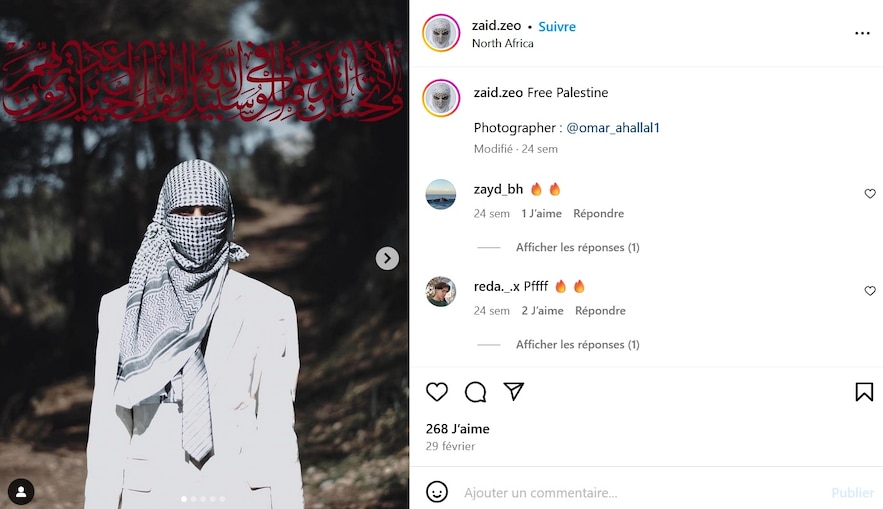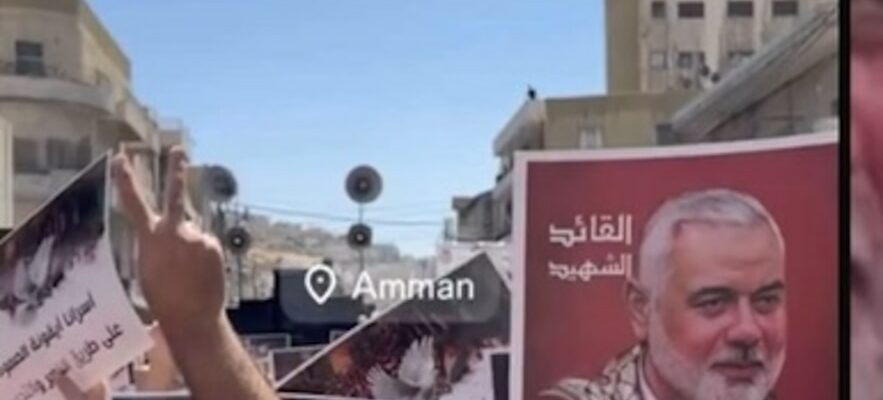Thousands of people gather in Amman (Jordan), after Friday prayers on August 16, under the Hamas flag. Since the assassination on July 31 of Ismail Haniyeh, leader of the Islamist organization, the demonstrators have expressed their anger. The demands of the demonstration are clear to those who know the region, not only because of the most repeated slogan, “Labbaika Ya Aqsa” (“We are coming, O Aqsa”), very common among Sunnis and Shiites, and which means the liberation of the al-Aqsa mosque from any Jewish presence.
But also through the photos of Haniyeh, abundantly brandished and accompanied by a Quranic verse calligraphed in Arabic: “There are, among the believers, men who were sincere in their commitment to Allah.” This verse is the most popular among jihadists in the Middle East to pay tribute to the “martyrs” who fell in the fight against the infidels. It was found alongside the photos of Ahmed Yassin, founder of Hamas, and his brief successor Abdel Aziz al-Rantissi, both assassinated in 2004 by Israel. Now, the verse is omnipresent in southern Lebanon, with huge portraits of the many dead of the Hezbollah militia.
A screenshot from Taha Bouhafs’ Instagram account showing a portrait of Ismail Haniyeh held up during the protest in Amman.
© / /
Rima Hassan was present at this demonstration alongside French activist Taha Bouhafs. We heard chants of “Come on, come on Hamas, you are the cannon and we are the bullets”. The rebellious European MP, a “Palestinian refugee” as she likes to describe herself, explains that she went to Jordan for her artistic project, “Nakba Survivor”. The day after the demonstration, Rima Hassan gave an interview to InterviewThe magazine is now headed by Omar Harfouch, a Lebanese millionaire known for his political ambitions. After long condemning Hezbollah, the latter appears to have changed his tune after a 2022 visit to southern Lebanon, the stronghold of the Shiite organization, declaring: “I spoke to their youth, I didn’t see anyone carrying weapons. I even saw a church, which was surprising.”
Interview took the side of the MEP, describing the article published in The Point Who had revealed his participation in the demonstration as a “false accusation”. “The Friday protests in Amman are a gathering place for many Jordanians and are not exclusively political. It is inevitable that individuals with different perspectives participate, including various placards, some perhaps pro-Hamas, but the majority supporting the Palestinian cause more generally,” Rima Hassan defended herself. A message that she repeated the next day on her Instagram account, followed by 350,000 people: “In Amman, every Friday, there is a demonstration in support of Gaza, because it is the day of rest. This is not the first Friday demonstration that I participate in… Using a few photos of some protesters showing their support for Hamas is deeply dishonest, I am not responsible for who participates in the demonstration.”
Calls for violence are omnipresent
Since October 7, we can certainly observe a diversity of slogans and political parties participating in the demonstrations in Jordan. But the slogan “From the river to the sea, Palestine will be free”, a real call to destroy Israel, adopted by Hamas as well as by Rima Hassan herself, is unanimous. Following the conflict between Israel and Hamas, the intensification of tensions and Islamic domination in Jordanian society (between 50 and 70% of the population is of Palestinian origin), secular or pacifist voices have been made invisible. In the demonstrations, calls for violence and jihad are numerous: “With soul and blood, we sacrifice ourselves for you, O Aqsa”, “It is a jihad: victory or death”, “Our first demand is to burn the embassy [NDLR : israélienne] and to remove the ambassador”… Abu Obaida’s speeches are broadcast live. The masked spokesman for the Izz al-Din al-Qassam Brigades, the military wing of Hamas, announces the number of Israeli soldiers killed. After each of his speeches, the cry of “Allah Akbar” can be heard. The leader of the demonstrations repeats: “They say that Hamas is terrorist; we are all Hamas.”
Rima Hassan lived the first ten years of her life in Syria in the 1990s. A country where anti-Israeli propaganda and calls for the liberation of Palestine “to the last inch,” as former President Hafez al-Assad put it, punctuated the daily lives of its inhabitants. She should therefore recognize the ideological line that dominates the protests in Amman today.
A very committed singer
The same day, still on Instagram, Hassan posted a video of the demonstration accompanied by the song Resistance by Lebanese singer Julia Boutros: “The South has risen to resist. The history of fatherhood does not sleep. It writes on our land, the land of epics.” In this song, the “South” refers to Lebanon, and the “resistance” is that of Hezbollah, a group whose armed wing has been considered terrorist by the European Union since 2013. Julia Boutros had already sung lyrics by Hezbollah leader Hassan Nasrallah at the time of the 2006 war against Israel. Addressing his soldiers, Nasrallah had said: “I kiss your hands holding the trigger with which Allah shoots the murderers of his prophets, his servants and the corrupters of the earth.” Years later, in 2018, Boutros traveled to Damascus, where she met Bashar al-Assad and expressed her support for him. At the time, Hezbollah was involved in numerous military operations targeting civilian areas in Syria, in order to defend Assad against the Syrian revolution. During these attacks, many civilians were killed or injured, and thousands more were forced to flee.
In May, Rima Hassan travelled to Tunis for a forum, Maghreb-Machrek. Also present were Sami Abu Zuhri, Hamas spokesman, and Youssef Hamdan, Hamas representative in Algeria, as well as Jamil Mazhar, deputy secretary general of the Popular Front for the Liberation of Palestine (PFLP), recognised as a terrorist organisation by the European Union and the United States.
Masked by a keffiyeh
In InterviewRima Hassan said her trip to Jordan was motivated by an art project to document Palestinian refugees, and that “her participation in the protests was part of her general commitment to Palestinian rights.” The project, “Nakba Survivor,” features photos of people wearing keffiyehs in various Palestinian camps. The majority of them are children. One of the photos posted on her Instagram account features another Quranic verse favored by jihadists: “Think not of those who are killed in the cause of Allah as dead. Rather, they are alive, with their Lord, well provided for.”

A screenshot from Rima Hassan’s Instagram account.
© / /
It may seem surprising to see an elected official representing France in the European Parliament mix cultural projects and Islamist references in this way. But for those who follow the career of Rima Hassan, who has always refused to condemn Hamas as a terrorist movement, there is nothing surprising about this: the activist is a master in the art of ambiguity.
* A writer and poet born in Damascus, Omar Youssef Souleimane took part in the demonstrations against the regime of Bashar al-Assad, but, hunted by the secret services, had to flee Syria in 2012. A refugee in France, he published with Flammarion The Little Terrorist, The Last Syrian, A room in exile, and recently To be French.
.
